Many Beagle owners find themselves wondering, “When do Beagles calm down?” It’s a question that echoes in the minds of those navigating the whirlwind of puppy energy. Typically, these lively pups begin to mellow out around the age of two. In this guide, we’ll explore the journey from high-energy antics to a more serene maturity, offering practical tips to help you soothe your spirited Beagle and enjoy the calmer side of their charming personality.
Key Takeaways
- Beagles typically start calming down around the two-year mark, but they still require regular exercise and mental stimulation throughout their lives to stay happy and healthy.
- Understanding and managing a Beagle’s high energy involves structured training, consistent routines, and ensuring both physical and mental engagement through activities like walks, interactive toys, and obedience training.
- Early socialization and training during puppyhood and adolescence are crucial in channeling a Beagle’s energy constructively and preventing behavioral issues, such as separation anxiety or excessive barking.
Find out how to train your beagle to be the well-behaved pup you desire – Read Free Report
Decoding Beagle Energy: When Will They Settle?
Think about an existence overflowing with exploration, faithfulness, and an unceasing tail wag. That’s the Beagle life in a nutshell. These affectionate companions are a bundle of joy, boundless energy, and unwavering loyalty, making them a perfect match for families that can match their zest for life. But it’s not all fun and games; sometimes, the very traits that make Beagles so loveable can also be their – and your – biggest challenge.
Determining when your Beagle will calm down can be a bit of a conundrum. This guide will delve into the heart of what makes a Beagle tick, fitting seamlessly into the lives of those with a high-energy lifestyle. But don’t be fooled, even the most active families can find themselves outpaced by a Beagle’s need for engagement. If you’re a novice in the dog-owning arena, be prepared for a challenge, as Beagles come with a robust set of training and care requirements. Yet, understanding the root cause behind their spirited nature and the trajectory of their maturation can make all the difference in nurturing a well-behaved, happy Beagle.
Understanding Beagle Energy Levels

Image created using AI
Watching a Beagle in action, you can’t help but admire their infinite energy. But what’s the deal with their high-octane lifestyle? Beagle energy levels are complex mix of genetics, environment, health, and diet. Think of them as the perfect storm for a life of exploration and activity. They’re the kids who never seem to tire at the playground, the adults who thrive in the fast-paced buzz of a busy city. This energy isn’t just for show; it’s an intrinsic part of the Beagle breed, a thread woven into the fabric of their very being.
For pet owners, this translates to an engaged beagle – in both body and mind – being a joyful one. Understanding their energetic phases is the key that unlocks the door to a harmonious relationship with your Beagle. It’s not about taming their spirit but channeling their high energy in ways that fulfill both their physical needs and their innate curiosity. Thus, we should navigate through the tumultuous energy of a Beagle and master the art of managing Beagles energy effectively.
Puppyhood: The Most Energetic Phase
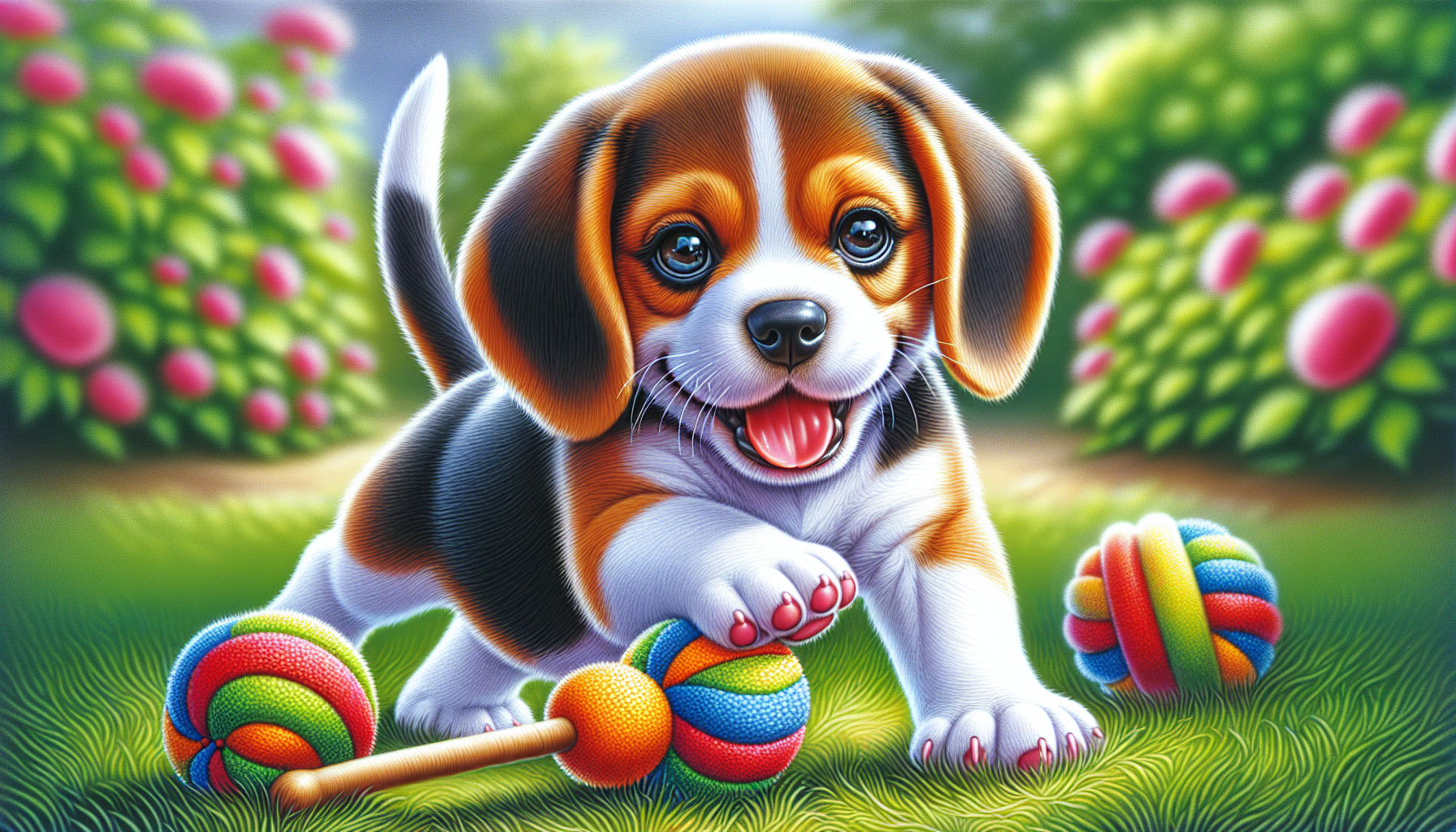
Image created using AI
Puppyhood for Beagles is akin to sprinting for athletes – it’s their time to truly shine. It’s an energetic phase where your home becomes a racetrack and your slippers the prize. This is the time to lay the groundwork for a well-adjusted adult life. It’s not just about letting them burn off pent up energy; it’s about guiding that energy towards growth and learning. Imagine the difference between a wild, untamed stream and a canal that directs water to nurture the land – that’s the power of proper exercise and early socialization for a beagle puppy.
Consistency serves as a guiding principle, much akin to a steady drumbeat, in a Beagle’s development. Potty training, crate training, and a diet tailored to their young age – all of these are essential melodies in the symphony of raising a Beagle pup. And while it may seem like your beagle is fast asleep one moment and a whirlwind the next, remember, this is just a phase. With patience and the right approach, you’re setting the stage for your beagle to transform into a well-adjusted adult.
Adolescence: Managing Boundless Enthusiasm
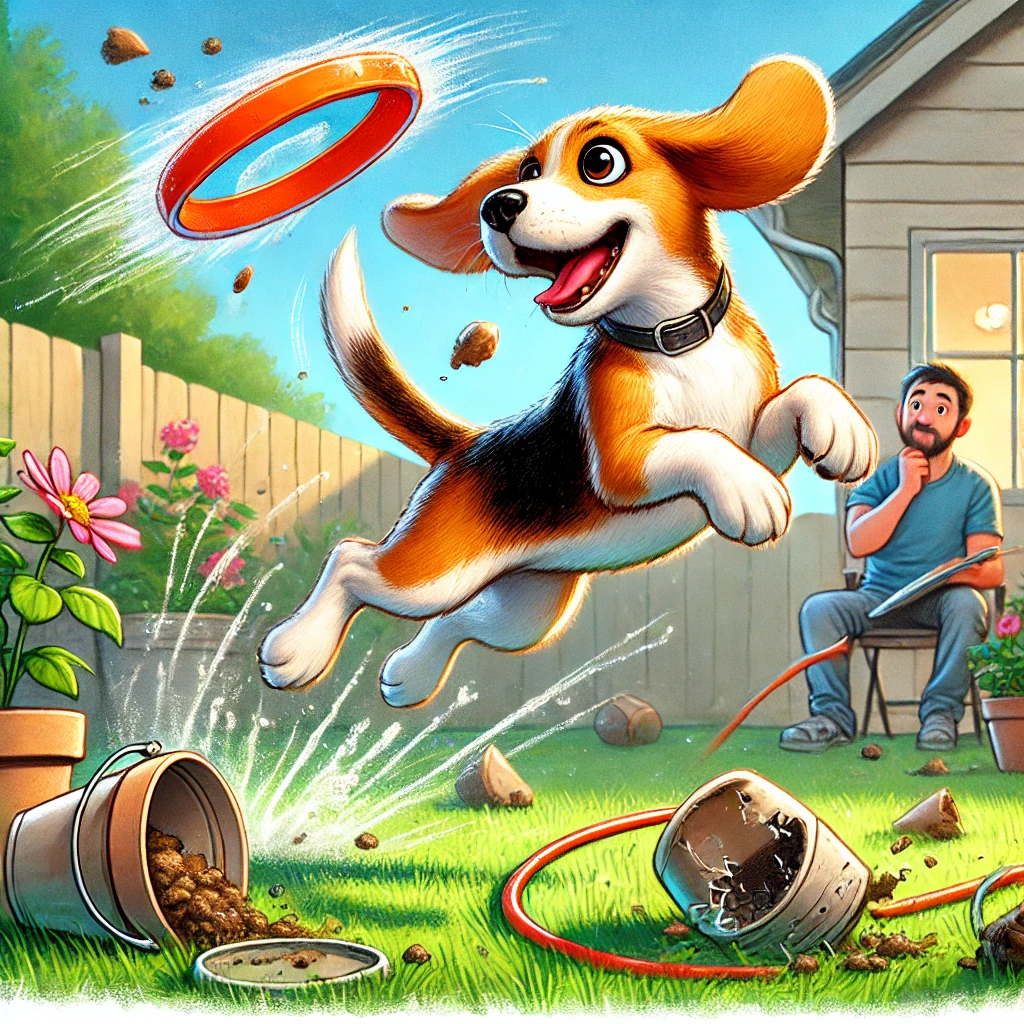
Image created using AI
Adolescence for Beagles, much like the turbulent teenage years in humans, is marked by boundless enthusiasm which can be both charming and tiring. During this stage, your furry friend will test boundaries, question authority, and seek independence, much like a human teenager. But fear not, this is also the prime time for socialization training, a period to reinforce the lessons of puppyhood and introduce new ones that will carry them through to adulthood.
This period calls for reinforcing fundamental commands – sit, stay, come – and introducing new challenges to keep their curious minds occupied. It’s about preventing boredom and nurturing positive behaviors, so your young Beagle learns to channel their energy constructively. Consistent training at this young age is not just about obedience; it’s about forming a bond, a mutual understanding that paves the way for a harmonious life together.
Adulthood: When Do Beagles Typically Calm Down?
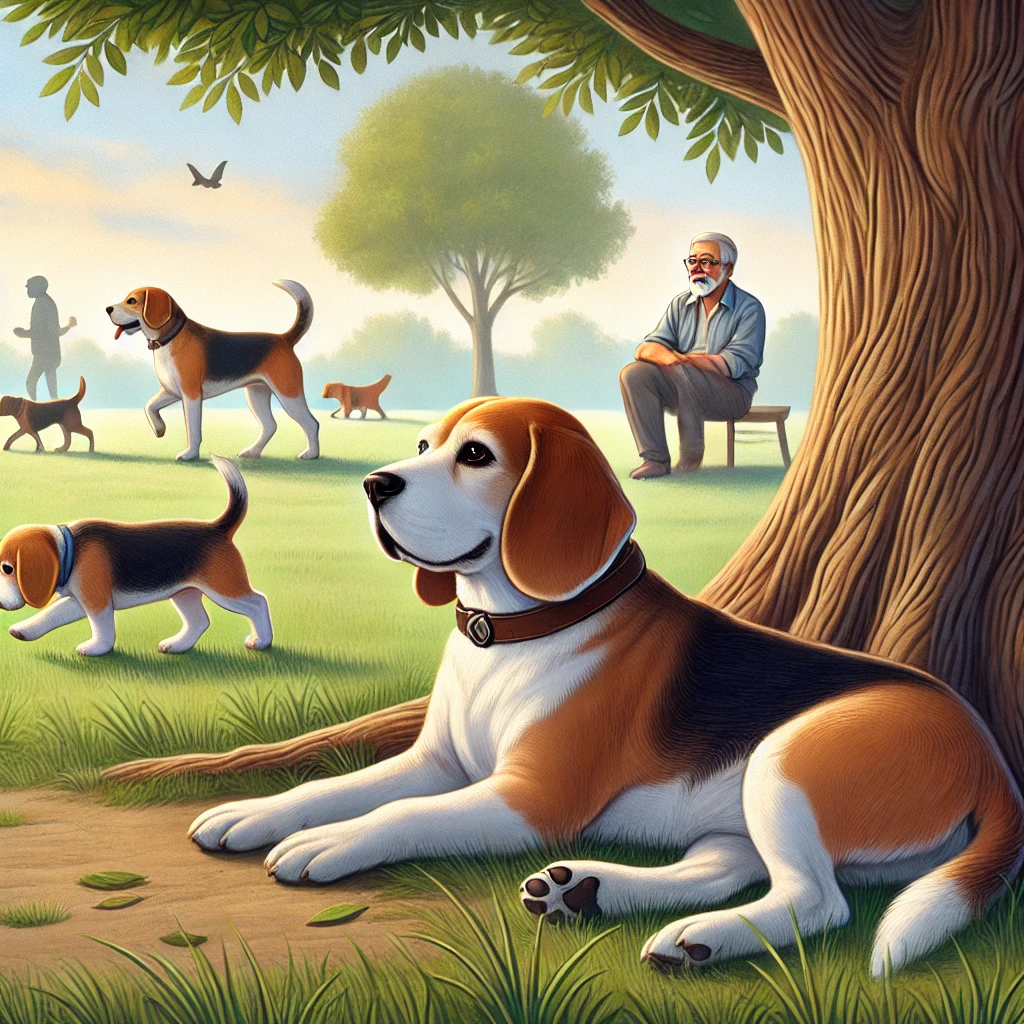
Image created using AI
The pressing question that lingers is: when do beagles start to calm down? If adolescence is the storm, then adulthood is the beagles calm that follows. Most Beagles begin to show signs of settling down around the two-year mark. It’s not an overnight change but a gradual shift, like the slow turning of leaves from green to gold. Yet, don’t be fooled into thinking that a calmer demeanor means a sedentary lifestyle. Beagles are a breed that thrives on activity, and even as adults, they require regular doses of adventure to maintain their beagle’s happiness.
Maintaining a routine can be the anchor that steadies a Beagle’s world. It’s about balance, finding the sweet spot between activity and rest that keeps your Beagle’s mind content and their body healthy. And while some may suggest that neutering is the silver bullet to calmness, remember, the high energy of Beagles is not a one-cause issue. It’s a tapestry of factors, each one requiring attention and understanding.
Factors Influencing Beagle Behavior
What fuels a Beagle’s behavior? It’s similar to understanding the creation of a masterpiece – not just one element, but a myriad of factors coming together in a harmonious blend of behavior. Genetics lay the foundation, with specific genes influencing how sociable a Beagle is and how much they seek human contact. The environment then shapes these tendencies, molding a Beagle’s behavior in response to their surroundings and experiences.
But it’s not just about nature; nurture plays a pivotal role too. The company a Beagle keeps, the food they eat, and the health they enjoy – all of these are brushstrokes on the canvas of their behavior. An anxious Beagle might chew more, while a spooked Beagle might bark at the slightest noise. Understanding these nuances is key to managing a Beagle’s energy and ensuring they grow into well-behaved adults, while also considering their natural hunting instincts.
Exercise Requirements for Beagles
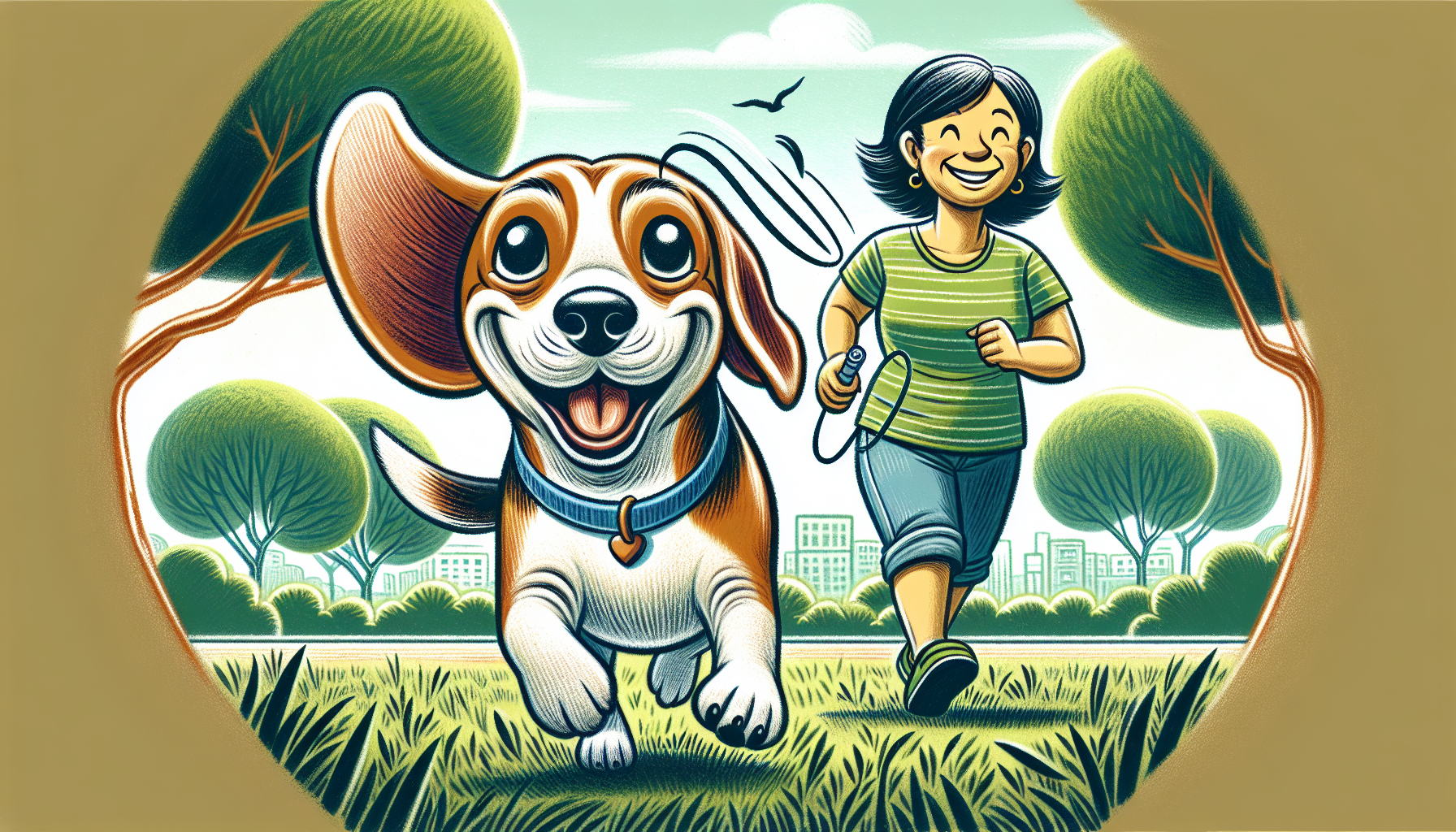
Image created using AI
Exercise is a topic of paramount importance as beagles demand a substantial amount of it. These spirited canines need at least 30-60 minutes of regular exercise each day to keep their tails wagging. Think of it as their daily dose of happiness, a necessary ingredient for a beagle happy life. But don’t stop there; some Beagles may need a more robust regimen to satisfy their adventurous spirit.
Here are some exercise ideas for your beagle:
- Daily walks or jogs
- Playtime in a fenced yard or dog park
- Interactive toys and puzzles
- Agility training or obedience classes
- Swimming or hiking
By providing your beagle with regular exercise, you can help them stay healthy, happy, and well-behaved.
Regular exercise for a Beagle isn’t just about preventing the roundness of the belly; it’s about shaping the fullness of their life. Physical activity helps them channel their natural instincts constructively, preventing the development of undesirable behaviors like excessive barking or digging. It’s the outlet that keeps their energy from becoming a whirlwind of chaos, the rhythm that keeps their life in harmony.
Mental Stimulation for a Happy Beagle
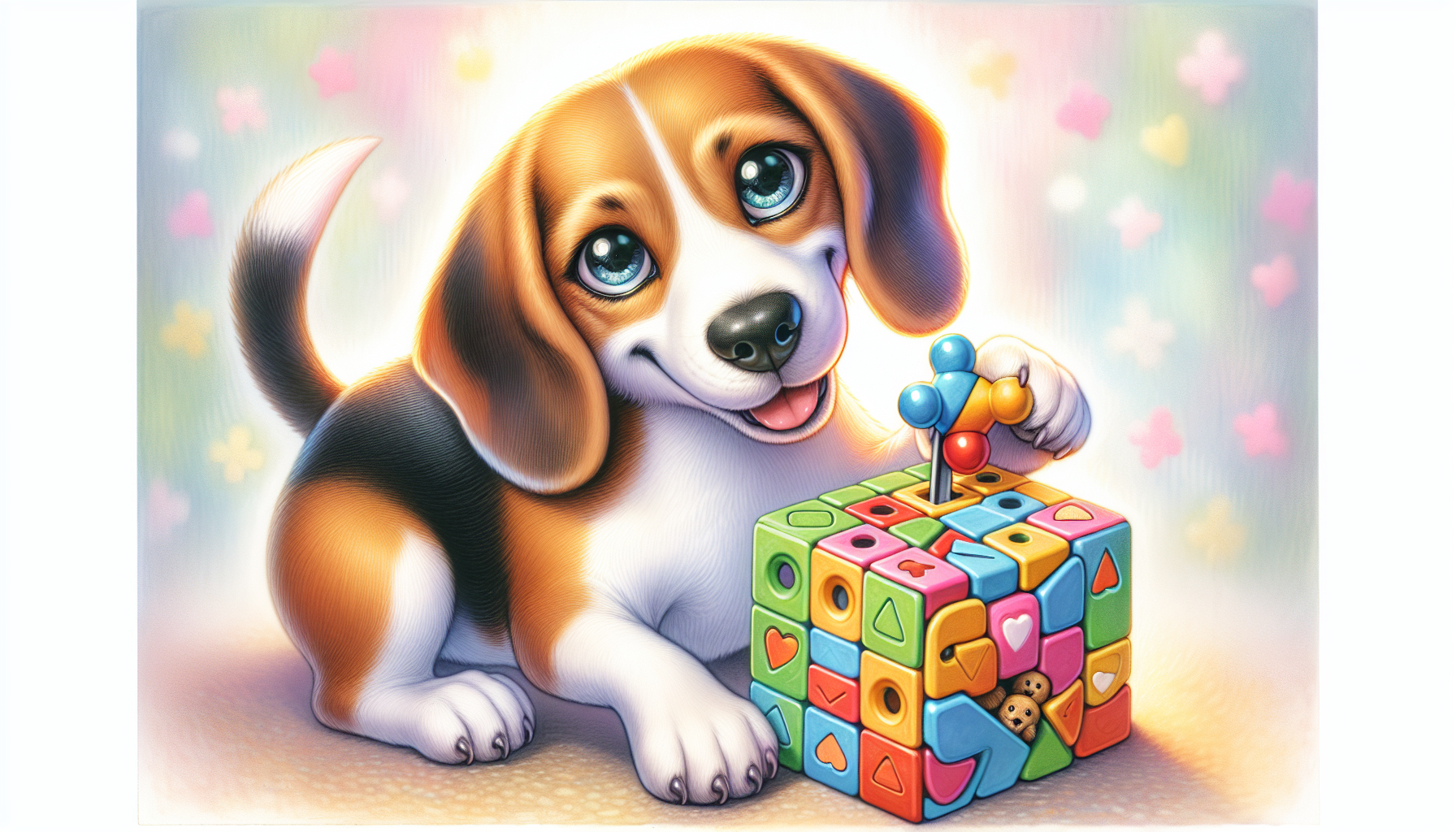
Image created using AI
And what about mental stimulation? A content Beagle is one whose intellect is stimulated just as much as its physical being. Mental stimulation is the spice that adds flavor to a Beagle’s life, preventing the blandness of boredom from setting in. Interactive toys, puzzle games, and scent work – these are the tools at your disposal to keep those gears turning in your Beagle’s mind.
Mental engagement for a Beagle is about more than just killing time; it’s about enriching their life, giving them a sense of purpose and joy. A mentally stimulated Beagle is less likely to seek mischief and more likely to settle into a well-behaved companion. It’s about quality time spent together, exploring new games and challenges that keep their minds sharp and their hearts full.
Effective Training Techniques
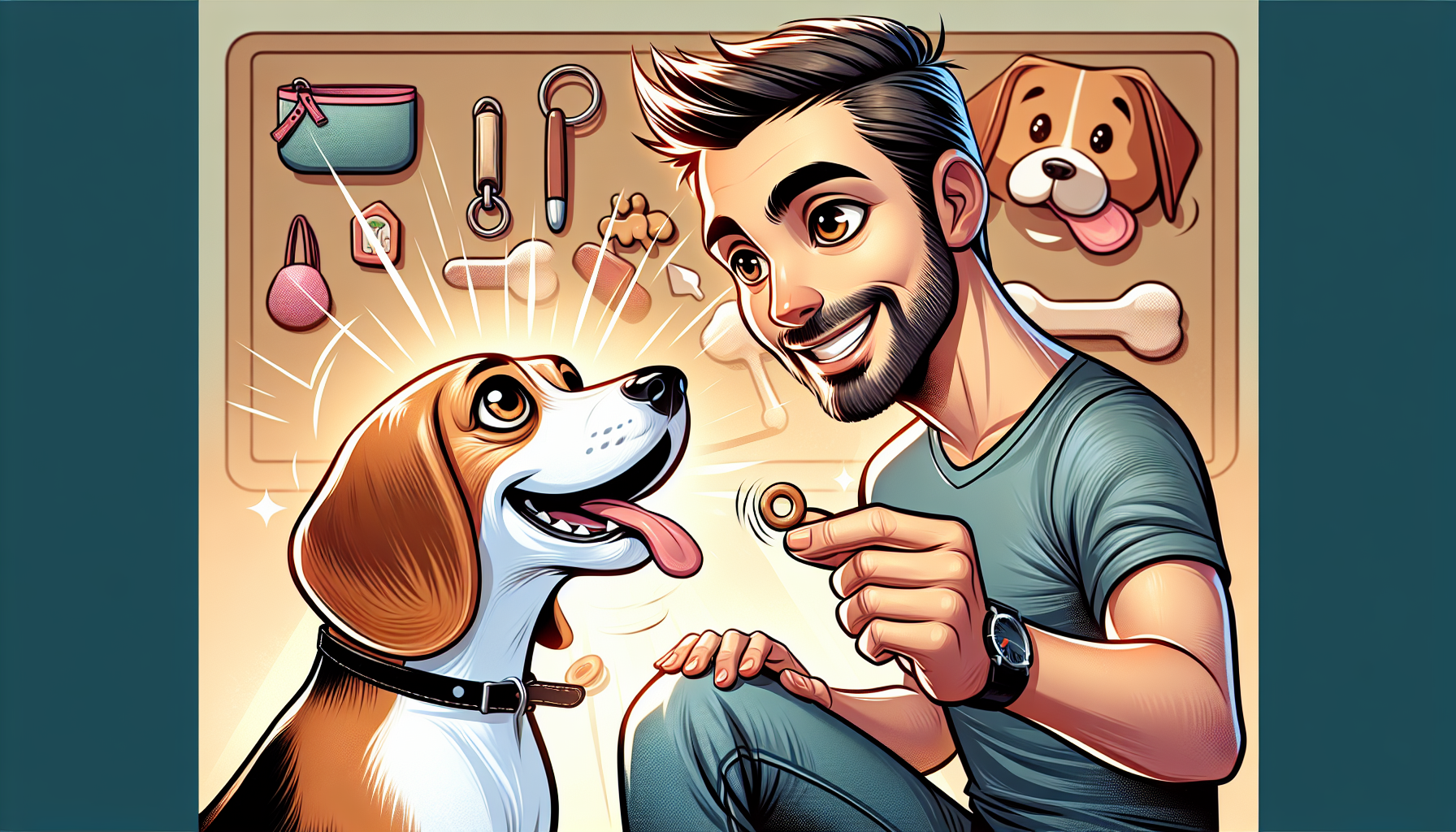
Image created using AI
Training a Beagle involves a blend of artistry and scientific understanding. It starts with the basics – the sit, the stay, the come – commands that form the bedrock of communication between you and your furry friend. But effective training doesn’t stop at the basics. It’s about building on them, introducing new challenges that keep your Beagle mentally stimulated and eager to learn. Some key training commands to teach your Beagle include:
- Sit
- Stay
- Come
- Down
- Leave it
- Drop it
- Heel
- Off
- Wait
- Quiet
By teaching your Beagle these commands, you can establish a strong foundation for obedience and ensure a well-behaved and happy dog.
Positive reinforcement is the golden rule here, a method proven to yield results and strengthen your bond with your Beagle. Treats, praise, and ample opportunities for interactive play – these are the building blocks of a training regime that respects and harnesses a Beagle’s natural enthusiasm.
Remember, a well-trained Beagle is a happy Beagle, and a happy Beagle makes for a harmonious home with beagle puppies. As scent hounds, their training is essential for a fulfilling life.
Coping with Behavioral Challenges
Each Beagle, being a unique individual, brings along a spectrum of behavioral challenges. Separation anxiety, for instance, can be a significant hurdle for both Beagle and owner, manifesting in a myriad of distressing symptoms. Addressing these challenges requires a blend of patience, consistency, and understanding – there is no one-size-fits-all solution.
Identifying the root cause of behavioral issues is the first step towards resolution. This might mean adjusting your Beagle’s routine, providing more mental and physical outlets for their energy, or even seeking the help of a professional dog trainer. It’s a journey, not a sprint, but with the right approach, even the most challenging behaviors can be managed and transformed.
Maintaining a Beagle's Health

Image created using AI
A content Beagle is a healthy one, and providing them with essential Beagle supplies and accessories plays a pivotal role in their well-being. Regular veterinary check-ups, a balanced diet, and the right nutrition are fundamental. Each element is vital in ensuring your Beagle's health and vitality. But caring for a Beagle goes beyond basic needs; it includes monitoring their weight, adjusting their diet, and maintaining their coat and skin with appropriate grooming supplies. Explore our range of Beagle essentials that support these daily care routines and enhance your pet's life. Check out our recommended products to ensure your furry friend’s long and joyful life. Visit our shop here for all your Beagle needs.
Real-Life Experiences from Beagle Owners
Real-world insights hold invaluable worth, and who could provide them better than fellow Beagle owners? Take Mac, a nine-month-old bundle of energy who had a penchant for chewing baby toys and testing the limits of personal space. It was a journey for Mac and his owners, one that involved setting boundaries, both physical and behavioral, and finding appropriate chew toys to establish a respectful and harmonious household. Mac’s owners also learned from observing other dogs and their interactions, which helped them better understand their own Beagle’s behavior.
Mac’s story is a testament to the power of consistency and the importance of non-verbal communication in training. By standing up and facing him while giving commands, his owners tapped into the universal language of dogs, guiding Mac towards a more respectful and well-behaved demeanor. These are the stories that resonate, that remind us we’re not alone in our journey with our Beagle companions.
Summary
As our journey comes to a close, let’s take a moment to reflect on the ground we’ve covered. From the whirlwind of puppyhood to the steadier pace of adulthood, we’ve explored the many facets of a Beagle’s life. We’ve learned that managing a Beagle’s energy is not about suppression but about understanding and channeling their zest for life into positive behaviors.
Remember, the key to a happy Beagle is a balance – a blend of physical exercise, mental stimulation, consistent training, and, of course, a healthy dose of love. Embrace the journey, enjoy the chaos, and know that with the right approach, you and your Beagle can navigate the path of life together in harmony. So, take these tips, apply them with patience and joy, and watch as your Beagle blossoms into the loyal, loving companion you know they can be.
Frequently Asked Questions
At what age do Beagles typically start to calm down?
Around the age of two, beagles usually begin to settle down, however there may be some individual differences.
How much exercise does my Beagle need each day?
Your Beagle needs at least 30-60 minutes of exercise each day to stay healthy and happy, with some requiring over two hours depending on their energy levels.
Can mental stimulation affect my Beagle's behavior?
Yes, mental stimulation can significantly impact your Beagle's behavior by preventing boredom and destructive behaviors. Engaging in interactive toys, puzzle games, and scent work can help keep your dog's mind active.
What are some effective training techniques for Beagles?
To effectively train your Beagle, start with basic commands like sit, stay, and come, and use positive reinforcement such as treats and praise. Consistent training and introducing new challenges can help manage your Beagle's behavior and energy levels.
How can I help my Beagle cope with separation anxiety?
To help your Beagle cope with separation anxiety, establish a regular schedule, provide plenty of exercise and mental stimulation, and consider seeking help from a professional if needed. Doing so can contribute to managing this behavioral issue.
Learn how to train your beagle to be the well-behaved dog you desire –> Access our Free Report
Shop for beagle-themed products and gifts that beagle enthusiasts will love.

